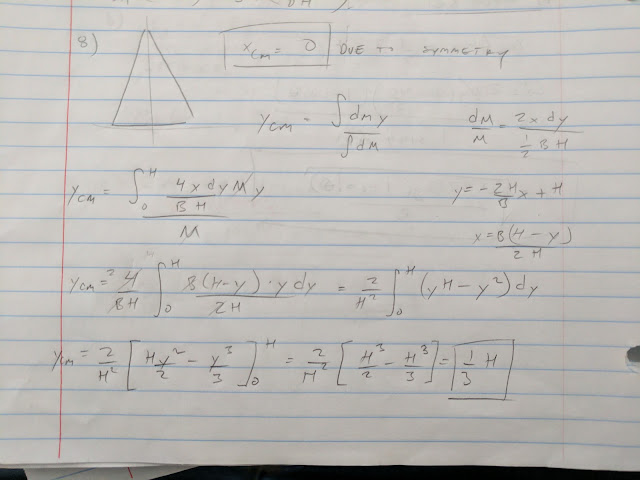Physical Pendulum Lab
Joel Cook
Nina Song
Eric Chong
Lab performed June 7, 2017
In this lab, we were attempting to predict the period of oscillation for various geometric shapes. By measuring the period in lab we can confirm the accuracy of our predictions.
Theory: We can calculate the moment of inertia of a geometric object, such as a triangle or square, by using calculus, center of mass, and the parallel axis theorem.
To find the moment of inertia, we can integrate:
dI = dm*r^2
where dm is a small "piece" of mass, r is the radius, and dI is a small part of the moment of inertia.
The center of mass of an object can be found by using the equation:
center of mass (in x or y direction) = mass 1*distance from origin + mass 2*distance from origin + ...
mass 1 + mass 2 +...
or by using calculus to integrate:
center of mass = integral of dm * x
integral of dm
Finally, the parallel axis theorem states that the moment of inertia of an object around an axis other than the center of mass can be found by:
I (new axis) = I (center of mass) + M (mass) * h (distance from center of mass) ^2
Procedure:
The experiment involves predicting the period of oscillation for flat, isosceles triangle and a flat semicircle. The equations above were used to predict the period of oscillation from a small displacement of each object. The values predicted were then compared to values obtained experimentally.
Isosceles triangle:
A ruler was used to measure the base and height dimension of a cardboard triangle. Two paper clips were attached to the top of the triangle to provide an axis of rotation. A rod was clamped to a ring stand and a flattened paper clip was taped to the rod, as shown below:
A photo-gate was setup below the triangle and a strip of paper was attached to the triangle. The strip of paper crosses the beam of the photo-gate allowing for measurement of the period of oscillation. A preconfigured file for measuring period of a pendulum was selected in Logger Pro. The triangle was displaced slightly and the period was measured and recorded in Logger Pro.
Semicircle:
The same setup as previously described was used for the semicircle, as shown below.
The semicircle was displaced in the same manner as previously described and Logger Pro was again utilized the measure and record the period of oscillation.
Data/Analysis:
Our prediction for the period for the triangle was calculated as shown:
Center of mass of triangle:
Moment of inertia of triangle rotating about apex of triangle:
Newton's second law to obtain period:
Period of 0.674 seconds
The period of oscillation of the triangle was measured, as shown below:
The period for the triangle was approximately 0.6677 seconds. The difference between the measured value and the predicted value was approximately 0.9%.
The period for the semicircle was predicted as shown below:
Center of mass of semicircle:
Moment of inertia of semicircle rotating about center of mass:
Moment of inertia of semicircle about axis at top of arc:
Period of semicircle using Newton's Second Law:
Predicted period of 0.708 seconds.
The period for the semicircle as measured by Logger Pro:
The period was approximately 0.7107 seconds. The difference between the measured value and the predicted value was approximately 0.4%.
Conclusion:
To address the impact of the added mass from the paper clips and tape it is important to remember that the moment of inertia of an object increases as the distance from the axis of rotation increases. For both cases in this experiment, the mass of the clips was adjacent to the axis of rotation so the impact from these is negligible for our purposes. The masking tape and strip of paper at the bottom of the objects would have a greater impact on the moment of inertia than the paper clips but the mass of the tape and paper is much smaller than the mass of the cardboard so the impact is quite small. Other factors may have impacted the experiment, including the shape not oscillating only in the horizontal plane, the low accuracy of a ruler for measuring lengths, and the precision of attaching the paper clips exactly at the top of each object. These factors would have some affect on the experiment but not enough to appreciably impact the results. In conclusion, the experiment was successful as the difference between the calculated and measured period of oscillation for both objects was within 1% of each other.











No comments:
Post a Comment